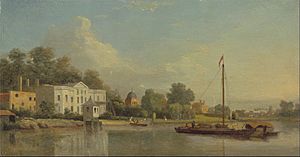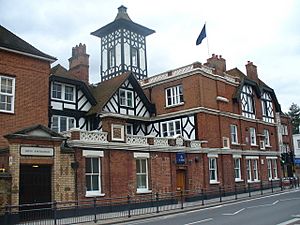Pope's villa facts for kids
Pope's Villa was the home of a famous English writer named Alexander Pope. He lived there in Twickenham, a village near London, starting in 1719. Pope created beautiful gardens and a special underground cave, which he called a grotto. His house and grotto became very famous and were shown in many poems and artworks during the 1700s and 1800s.
Around 1845, a new house was built near the original site. This new house is also called Pope's Villa and has been used as a school for many years. Luckily, Pope's Grotto still exists today! It is a special historical site, protected by Historic England, and is sometimes open for people to visit.
Contents
Alexander Pope's First Home in Twickenham


In 1719, Alexander Pope moved to Twickenham. Many rich people from London had homes there. He rented some land right by the River Thames. There were a few small houses on the land. Pope tore down one house and part of another.
He hired a famous architect named James Gibbs to design his new home. It was built in a grand style called Palladian style. Later, in 1733, another architect, William Kent, added a porch to the house.
Pictures from Pope's time show his house looked like a typical large country home from the 1700s. It had three floors. The middle part of the house had three windows on each floor, and there were two smaller sections on each side. A unique part of the house was a large, rounded arch on the ground floor, right in the middle. This arch looked like an entrance to a building by the water in Venice, Italy. Since Pope's house was so close to the River Thames, this was probably on purpose!
Pope also planted a weeping willow tree near his house. Some people believe a tree trunk in the grotto today came from this tree. He also designed one of the first "picturesque" gardens across the street. These gardens looked natural but were carefully planned. Pope said his garden had a "Theatre," an "Arcade," a "Bowling Green," and a "Grove."
In 1720, Pope got permission to build a tunnel from under his house to his garden. From this main tunnel, he created a special, romantic grotto.
Changes to the House After Pope's Death
After Alexander Pope died in 1744, a man named Sir William Stanhope bought the house. He made it bigger in 1758 by adding new sections on the sides. He also made the garden larger and built a second tunnel. Parts of this tunnel still exist today and are protected historical sites.
The house stayed in Stanhope's family until 1807. Then, a woman named Baroness Howe bought it. She had the house torn down the very next year, in 1808. She built a new house nearby and also changed some of the decorations in the grotto and the garden. Baroness Howe's house was later partly taken down, and what was left became two separate houses.
Pope's villa, its gardens, and the grotto were often written about in poems and shown in art. Many artists drew and painted the house, especially the side facing the river. There are at least 55 drawings, paintings, and prints of the house and grotto from between 1730 and 1888. Even J. M. W. Turner, a famous painter who lived nearby, was sad when the house was demolished. His painting Pope's Villa at Twickenham shows his sadness.
Pope's Grotto: An Underground Wonder
When Pope first built his grotto, he wanted it to look like a natural cave. In 1725, he wrote to a friend, describing it: "I have finished my underground Way and Grotto... I found a spring of the clearest water, which falls in a constant stream, that echoes through the Cavern day and night."
He also explained how special it was: "When you close the doors of this Grotto, it instantly becomes a dark room, like a camera obscura. On its walls, all the things from the River, Hills, Woods, and Boats create a moving picture."
Pope also described how it looked when lit up: "When you want to light it up, it offers a very different scene: it is decorated with Shells mixed with Pieces of Looking-glass in sharp shapes... when a Lamp is hung in the Middle, a thousand pointed rays glitter and reflect all over the place."
Later, in 1739, Pope decided to change the grotto to look more like a mine. For four years, he decorated it with beautiful materials. These included marble, shiny ores like mundic, and snakestones. He also added stalactites, crystals, and even diamonds from places like Bristol and Cornwall. A geologist named William Borlase helped him get many of these materials. Sir Hans Sloane gave Pope two pieces of basalt rock from the Giant's Causeway in Ireland. One of these pieces is still in the grotto today!
After Pope died in 1744, the grotto was very popular with tourists. Many visitors supposedly took small pieces of the decorations as souvenirs.
Most of Pope's Grotto still exists today, hidden beneath buildings from the 1900s. It is sometimes open to the public during Twickenham's Festival Week. It was made a Grade II* listed building in 1952, meaning it's a very important historical site.
Today, the grotto has a covered walkway (loggia) and a main room with two smaller "chapels" branching off it. Not much of the original decorations from Pope's time are left. The religious decorations you see now, like a carved stone of the Crown of Thorns in the ceiling, a shield with the Five Wounds of Christ, and statues of the Virgin Mary and St James, are believed to be from the 1800s. The tunnel that once led to the garden has been made wider and longer.
Pope's Villa: The New House
In 1842, a tea merchant named Thomas Young bought the property. He had a new house built on the same spot where Pope's villa once stood. This new house was designed in a style called 'Tudor Gothic' by Henry Edward Kendall Jr. It was finished around 1845.
Since 1919, this building has been a school. First, it was St. Catherine's Convent School. Since 2011, it has been Radnor House Independent School. The building has been changed quite a bit over the years to suit its use as a school.



